Manual drilling of wells for water
Not all owners of suburban areas can boast of having a centralized water supply. An alternative to a centralized water supply may be a drilled well or a well. But not always the depth of the aquifer makes it possible to build a well, then drilling a well remains the only option for watering the house. Drilling can be ordered from the organization, which is very expensive, or you can drill it yourself. Manual drilling of wells with your own hands is quite a feasible task; in this way, you can drill a well with a depth of up to 30 m, which in most cases will be sufficient to get good quality water with the required flow rate.
Manual drilling methods
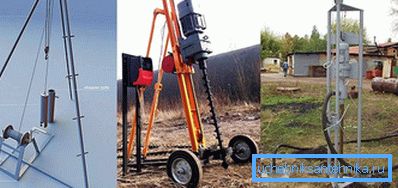
In the practice of manual drilling of wells for water, three methods of drilling are most often used:
- shock cable;
- screw;
- hydrodrilling;
These drilling methods involve the use of human effort only. With this method, they practically do not resort to the use of mechanisms, with the exception of electric winches and a motor pump during hydraulic drilling. Some drilling methods are used at the same time - it is a shock-cable and auger, which speeds up the drilling process. Drills for all methods can be made independently.
Manual Auger Drilling
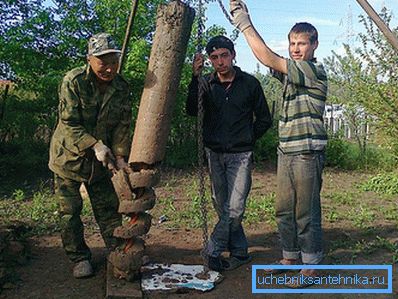
Auger drilling is one of the most common methods of manual drilling, which is a rotary drilling using a blade bit. The destroyed breed from a face is removed by means of the screw. This type of manual drilling can be used in soft rocks for the construction of shallow filter wells up to 30 m.
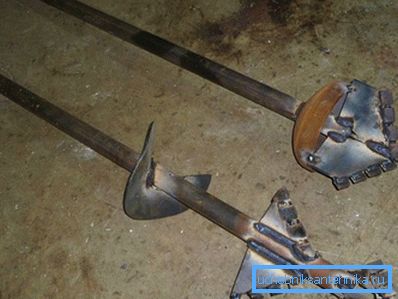
The drill for manual drilling can be made of improvised materials. It is possible to remake the fishing drill, having preliminarily strengthened the cutting edges, having welded additional metal strips, in the upper part of the drill it is necessary to weld the coupling for fastening the drill to the rods. As the rods most often used round metal pipe diameter? inches or square size 25? 25 mm. The length of the section of the drill rod should be from 2 to 4 m, with longer drill pipes inconvenient to handle. To connect the rods to each other, pipe lengths with a diameter of 32 mm or 30? 30 mm are used, in case the pipe is square. On the one hand, they are welded to the rod, and on the other hand, they are connected to the other rod with a pin or bolt joint.
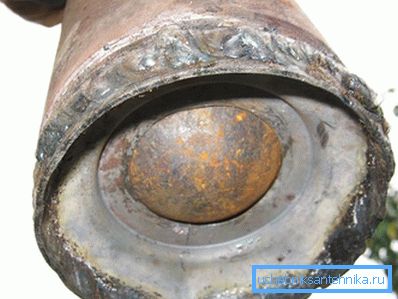
For more efficient drilling, you need to choose the right bit, which is selected depending on the type of soil. A conventional auger is used for drilling in unstable rocks, a long shell is used to pass flooding or water-saturated sand, a stable spoon is used in stable soils, clayey sands, loams, and a coil spoon is used in dense clays and gravel clays. The design of the drill-spoon consists of a steel cylinder with a longitudinal slit, with cutting blades welded from below. A simpler construction of the drill-spoon can be made of flat steel, for this you need to take two pieces of steel strip with a length of about 40 cm and butt weld to the arc. The lower part of the bands is spirally arched, so that they acquire a bucket shape, and are interconnected by welding. The cutting part needs to be sharpened, to increase the strength of the drill is subjected to heat treatment. Drills with a diameter of not more than 100 mm are used for manual drilling, otherwise it will be difficult to turn. With the help of such a drill, it is possible to deepen 35–40 cm in one penetration.
Drilling order
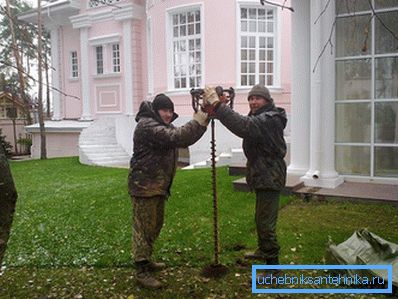
Before manually drilling, you can dig a hole, measuring 1.5? 1.5 m and a depth of up to 2 m. The size may be less - it all depends on the type of soil. In very loose soil walls need to be fixed with boards. The hole is digging in order to prevent the most fragile rock from shedding. In the future, a caisson will be installed in the excavated pit. After all the preparatory work they start to drill, you can drill from the boardwalk or from the ground, turning the drill by using a key or clamps.
If drilling is carried out in dense clay soils, and the depth of the well does not exceed 20 m, the casing of the well is performed after the end of drilling. As casing pipes most often use polyethylene pipes for water supply or pipes for drilling from PVC. In unstable soils, drilling is carried out simultaneously with the casing, extracting the soil directly from the casing, in such cases steel casing is used, since they often have to be driven. The diameter of the bit when drilling with a casing should be a few millimeters smaller than the internal diameter of the casing so that the drill can be easily removed from the well for cleaning. As the well depth increases, casing pipes grow, connecting them to each other with the help of threaded couplings.
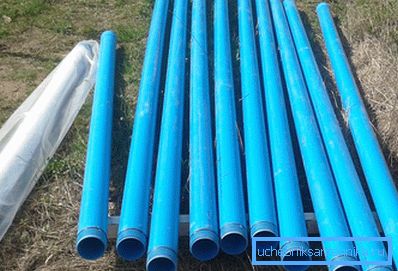
During drilling, it is not necessary to do more than 5 turns of the drill in one penetration, otherwise it will be hard to get it.
As the drill penetrates, it will be more difficult to turn it, to facilitate the process, water is poured into the well. To facilitate the lifting of the drill from the face above the hole, install a tripod with a block. You also need to constantly monitor the verticality of the well, if the barrel moves away from the vertical, it must be leveled with wooden wedges, hammering them between the casing and the wall of the well.
Drilling continues until the aquifer is opened and the maximum flow has been completed to maximize water loss. To prevent the well from sanding in the future, it is important to pass the aquifer to the water stop. Determine that you have reached the aquifer can be on the size of the sand and its humidity, the larger the sand, the better the water loss.
Cable drilling

A more extensive use in manual drilling of wells has been provided by the percussion-cable method using zhelonka as a chisel. The principle of drilling is to destroy the rock with the help of a bitch that, striking a rock, breaks it down and captures it. The shell may be with a ball valve, a disc valve, and more complex with a piston valve. The use of a particular construction depends on the type of rock being extracted.
Shock drilling involves the use of a tripod, which is installed above the drilling site, its height can be up to 2 meters, sometimes higher. At the top point of the tripod, a block is installed, through which a cable or rope is thrown, and a small tube is tied to it. The slug is raised above the bottom to a height of about 1 m and lowered sharply, the operation is repeated until it is full. In order to prevent the collapse of the walls, drilling is carried out simultaneously with the casing, the diameter of the casing string must be such that it is free to enter the shell. As drilling proceeds, the casing is lowered, and when the casing is turned, it is loaded with ballast to precipitate the pipe into the ground.
Hydraulic drilling

Hydraulic drilling is used less frequently as it has a number of drawbacks, one of which is the presence of a certain amount of water in the area, in order to drill a well, it will take at least 5 m3 water, as well as the motor pump. The drilling process itself consists in the destruction of the rock with a drilling tool and water, which is fed through the drill rods into the face and washes away the destroyed rock to the top. The drilling tool itself is a metal pipe, less often a PP pipe, at the end of which a drill is welded (screwed), a 90 ° outlet is screwed on top, to which the return water supply hose is connected, the handle is also attached at the top, with the help of which the bar is turned. Before the start of drilling, two pits are digging for return water. Drilling lead, turning the rod clockwise and counterclockwise, and tapping on the bottom of the well. Drilling is carried out, as a rule, without casing, as the mud keeps the walls of the well from sprinkling. With the help of hydro drilling you can make a well up to 20 m and with a diameter up to 50 mm in soft rocks.
Well equipment
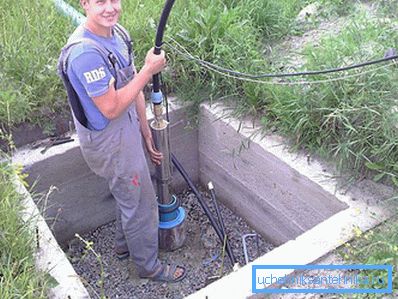
After the end of drilling (auger, impact-cable), metal casing, as a rule, is extracted using a jack, and the well is surrounded with polyethylene pipes equipped with a filter.
If the well is drilled with a diameter of 60 mm or more, a submersible pump is lowered inside, if the diameter of the well is smaller, then a water pipe with a strainer and a check valve at the end is lowered into the well. A surface pump is used as water-lifting equipment, but, again, it can be used if the dynamic level in the well does not fall below 9 m. Therefore, before starting to drill, it is necessary to approximately determine the level of groundwater from which the water intake is planned. it was possible to focus on the diameter of the well.
We also recommend reading the articles:
- When it is better to drill a well on the water.
- Installation of the pump in the well with your own hands.
Video
See how you can independently make a well on the water: